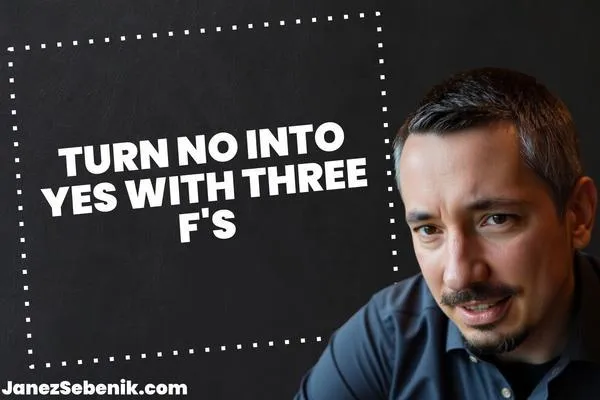
What are the 3 F's for handling objections?
Ever been hit with a "no" during a sales pitch? It's like getting smacked with a wet fish. But what if I told you there's a secret weapon to turn that "no" into a "yes"?
Enter the 3 F's method. This powerful technique helps you handle sales objections like a pro, using three simple steps: Feel, Felt, and Found. It's like a magic spell for salespeople, but without the wand-waving.
The 3 F's method is all about empathy and understanding. You'll learn to connect with your prospects, show them you get where they're coming from, and guide them to a solution. It's like being a mind reader, but way less creepy.
Key Takeaways
The 3 F's method uses Feel, Felt, and Found to handle objections
This technique builds rapport and redirects focus to solutions
Mastering the 3 F's can significantly boost your sales performance
Understanding Sales Objections
Sales objections are roadblocks that pop up during your pitch. They're not the end of the world, but you gotta know how to handle them. Let's dig into what these objections look like and why they happen.
Common Sales Objections
You've heard 'em before. "It's too expensive." "We don't need it right now." "I need to talk to my boss." These are the classics.
Price objections? They're the biggie. Your job is to show the value, not just the cost.
"We're happy with our current solution." That's another tough one. You gotta prove you're better.
Trust issues? Yep, those come up too. People are wary of salespeople. Can't blame 'em.
Remember, objections aren't always bad. They show interest. It's your chance to shine.
Psychology Behind Objections
Ever wonder why people object? It's not just to make your life hard, promise.
Fear of change is huge. People like what they know. New stuff? Scary.
Pain points are real. If they don't see a problem, they won't want a solution.
Some folks just hate being sold to. It's your job to not feel "salesy".
Budget concerns? That's often code for "I don't see the value yet."
Sometimes, it's just not the right time. But maybe you can change their mind on that.
Remember, objections are often just questions in disguise. Answer them right, and you're golden.
The 3 F's Method Explained
The 3 F's method is a powerful way to handle sales objections. It helps you connect with customers and turn their concerns into opportunities. Let's break it down.
Feel
You start by showing you get where they're coming from. It's all about empathy. When a customer raises an objection, don't freak out. Take a deep breath and say, "I understand how you feel."
This isn't just empty words. You need to really listen. Put yourself in their shoes. Maybe they think your product is too pricey. Or they're not sure it'll work for them.
Your job? Show them you're on their side. This builds trust fast. It's like telling them, "Hey, I'm not just here to sell. I'm here to help."
Felt
Now it's time to bring in some backup. Tell them about other customers who felt the same way. This is where social proof comes in handy.
You might say, "You know, I had a client who felt the exact same way last month." This shows the customer they're not alone. It's normal to have doubts.
But here's the kicker: those other customers changed their minds. This plants a seed. Maybe your current customer will too.
Found
Here's where you bring it home. Share what those other customers discovered after giving your product a shot. Did it boost their revenue? Save them time? Make their life easier?
Use specific examples. Numbers are great here. "They found their sales went up by 30% in the first quarter." Boom. That's hard to argue with.
This stage is about overcoming objections with real results. You're not just saying your product is great. You're proving it.
Remember, keep it real. If there were any hiccups or areas for improvement, mention those too. It shows you're honest and builds even more trust.
Implementing the 3 F's in Your Sales Conversations
Want to boost your sales game? The 3 F's method is your secret weapon. It's all about connecting with your customers and turning their doubts into opportunities.
Active Listening Techniques
You've got two ears and one mouth for a reason. Use 'em that way. When a customer speaks, shut up and listen. Really listen.
Nod your head. Make eye contact. Show them you're tuned in.
Ask follow-up questions. It shows you care and helps you dig deeper.
Repeat what they said in your own words. It proves you were paying attention and helps clear up any misunderstandings.
Remember, people love talking about themselves. Let them do it. You'll learn a ton and they'll feel heard.
Building Trust Through Conversation
Trust is like money in the bank. The more you have, the better off you are.
Be real. Drop the salesy act. People can smell fake from a mile away.
Share stories. Not just any stories, but ones that relate to their situation. It shows you get them.
Use their name. But don't overdo it. You're not a used car salesman.
Be curious. Ask questions about their business, their goals, their challenges. Show genuine interest.
Follow through. If you say you'll do something, do it. No excuses.
Turning Objections into Opportunities
Objections aren't roadblocks. They're stepping stones. Use them to get closer to the sale.
Don't get defensive. Thank them for bringing it up. It's a chance to clarify and address their concerns.
Use the Feel, Felt, Found method. "I understand how you feel. Others have felt the same way. But here's what they found..."
Dig deeper. Often, the first objection isn't the real one. Ask questions to uncover the root issue.
Offer solutions, not arguments. Your goal is to help, not to win a debate.
Practice, practice, practice. The more you handle objections, the better you'll get at turning them into sales.
Beyond the 3 F's: Advanced Strategies
The 3 F's are great, but let's kick it up a notch. These strategies will help you crush objections before they even come up. You'll learn how to handle money issues like a boss and create an environment where objections melt away.
Prospecting and Preemptive Tactics
Want to stop objections in their tracks? Start before the sale even begins. Do your homework on potential clients. Learn their pain points, budget, and decision-making process.
Tailor your pitch to address likely concerns upfront. It's like reading their mind.
Use social proof to your advantage. Share success stories from similar clients. This shows you've solved their problems before.
Practice active listening during calls. Pick up on subtle cues that might hint at future objections.
Lastly, always follow up. A quick check-in can nip brewing concerns in the bud.
Dealing with Budget Constraints
Money talks, but it doesn't have to shout. When faced with budget issues, get creative.
First, focus on value, not price. Show how your product saves time or boosts revenue.
Offer flexible payment plans. Breaking up costs can make big purchases more digestible.
Consider tiered pricing options. Let clients choose what fits their wallet.
Use the "Feel, Felt, Found" method to address price concerns. "I get how you feel. Others felt the same way. But they found our product pays for itself in X months."
If all else fails, be ready to walk away. Sometimes, the best deal is no deal.
Creating a Culture of Receptiveness
Want to make objections rare? Build a culture that welcomes feedback.
Train your team to see objections as opportunities, not obstacles. They're chances to improve your product or pitch.
Encourage open communication with clients. Regular check-ins can catch issues early.
Use surveys and feedback forms. Make it easy for clients to voice concerns.
Create a knowledge base of common objections and effective responses. Share it with your team.
Finally, celebrate when objections lead to better solutions. It shows you're always improving.
Conclusion
The 3 F's method is your secret weapon for handling sales objections. It's simple, effective, and gets results.
Remember: Feel, Felt, Found. That's all you need to know.
When a prospect throws an objection your way, don't panic. Use the 3 F's and watch the magic happen.
First, show them you understand how they feel. It's not rocket science, just basic empathy.
Next, tell them others felt the same way. You're not alone, buddy!
Finally, hit 'em with what those others found. The solution, the breakthrough, the game-changer.
It's like a sales kung fu move. Practice it, master it, and watch your close rates soar.
Don't overthink it. Keep it simple, keep it real, and keep closing those deals.
Now go out there and crush those objections!
